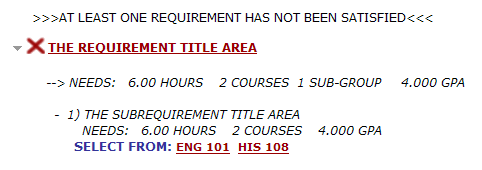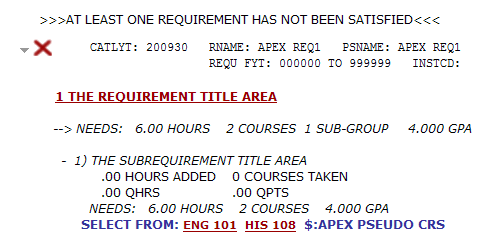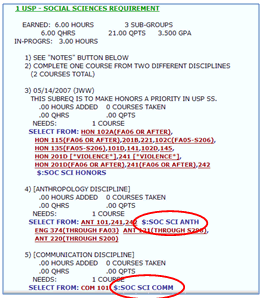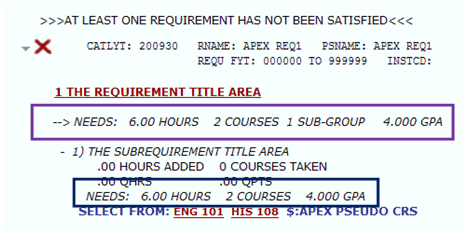COMMONLY USED TERMS
 EXCEPTION
EXCEPTION
 FULL LISTING AUDIT
FULL LISTING AUDIT
 PSEUDO COURSE
PSEUDO COURSE
 REQUIRED COURSE COUNT
REQUIRED COURSE COUNT
 REQUIRED HOUR COUNT
REQUIRED HOUR COUNT
 REQUIREMENT NAME
REQUIREMENT NAME
 REQUIREMENT LEVEL
REQUIREMENT LEVEL
 SUBREQUIREMENT LEVEL
SUBREQUIREMENT LEVEL
|
| |
EXCEPTION
An exception is an important tool
allowing official college decisions to be applied to an individual student's APEX
student record and audit report. Such modifications would aid in the
completion of a subrequirement and/or requirement. Several examples
of exceptions include a course substitution, a course waiver, an hour
waiver, and various other exceptions an advisor may experience as they
review their student's APEX report.
It is important to note that a FULL LISTING AUDIT may need to be produced
when processing exceptions. The FULL LISTING AUDIT is the starting
point for exceptions processing since it will provide the information,
normally suppressed on a normal audit, necessary to properly process an
exception. A detail description about the FULL LISTING AUDIT is located
in the below "Definitions" and "How to..." sections.
|
| |
| |
|
RETURN TO TOP OF SCREEN
|
| |
| |
FULL LISTING AUDIT
The FULL LISTING
AUDIT is an important tool for encoders to see what has been encoded
for each requirement and subrequirement including those items that
may have been suppressed from being displayed on a normal audit, the
style typically viewed by APEX advisors and students. The
FULL LISTING AUDIT is also important to the task of processing exceptions
because it contains the information needed for specific exceptions
including items such as the requirement name, the
subrequirement's pseudo course, and so on.
The following two graphics attempt to the show the differences
between a normal audit and a FULL LISTING AUDIT. The first graphic,
the "normal audit", has certain items suppressed from view, whereas
the FULL LISTING AUDIT displays all encoded information. Several
items that have been suppressed from the normal audit include the
subrequirement level's required hour count and the requirement
level's required course count.
The Normal Audit.

The FULL LISTING AUDIT.

PRODUCING A FULL LISTING AUDIT
STEP-1.
APEX is set up to automatically
select the radial button next to the area labeled "Run Default Programs Listed".
This area allows for an audit to be produced on the student's primary degree
program without having the APEX user to select it each time the APEX system is
accessed. If a Full Listing Audit is to be produced using the student's default
degree program, then select "L: Full Listing-Testing" located in the "List All"
field and click on "Submit a New Audit".
If a Full Listing Audit is to be produced in a "what-if" situation and not
on the student's default degree program, then select the radial button displayed
next to "Run Selected Program". The "What-if" area is inaccessible until this
radial button has been selected.
STEP-2.
Choose the appropriate "College",
"Major", and "Degree" in addition to the "Catalog Year". The "Degree Option"
is to be selected if the degree program offers multiple options, concentrations,
or tracks.
STEP-3.
Finally, within the
"List All" field select the option labeled as, "L: Full Listing - Testing", then click
"Submit a New Audit."
|
| |
| |
|
RETURN TO TOP OF SCREEN
|
| |
| |
PSEUDO COURSE VERSUS REQUIREMENT NAME
Entering exceptions may
involve either a requirement level's requirement name or the subrequirement
level's pseudo course. Both are important for exception processing
because they identify to APEX whether or not the exception is to be placed
against the requirement level or the subrequirement level. In other
words, if an exception is needed to modify something at the requirement
level the requirement name will be used, whereas a pseudo course will be used
to identify, to APEX, which subrequirement (within the requirement) needs the modification.
The below graphic is an example of a FULL LISTING AUDIT which will display
both the requirement name and pseudo course since these are typically
suppressed from view on a normal audit. For this example, the
requirement name, USP-SS, should be located in the upper, right
field labeled, "PSNAME:" (see blue box). The pseudo course
is a little different than the requirement name, but it is not difficult
to locate since all pseudo courses will have the dollar sign ($) attached.
The below graphic shows two main subrequirements titled "Anthropology
Discipline" and "Communication Discipline". Disregard the first subrequirement
because it is only being used to display text. After reviewing the two
subrequirements, it is apparent that the pseudo course unique to the "Anthropology
Discipline" is listed as $:SOC SCI ANTH (see top red oval) and the pseudo
course unique to the "Communication Discipline" is listed as $:SOC SCI COMM
(see bottom red oval).
Pseudo Course versus Requirement Name.

|
| |
| |
|
RETURN TO TOP OF SCREEN
|
| |
| |
REQUIRED COURSE COUNT
The below
graphic displays a requirement titled the APEX Requirement.
The APEX Subrequirement is a subrequirement within this requirement.
Behind the scenes, the encoder indicates to APEX what is being required
whether it is a specified amount of hours, courses, gpa, etc...
depending on what is minimally needed to fulfill either or both the
subrequirement and requirement levels.
Required Course Count.

SUBREQUIREMENT LEVEL
The subrequirement level required course count is located on what is referred to
as a "NEEDS" line at the subrequirement level. The blue box, located in
the above graphic, encases the subrequirement's "NEEDS" line where it reads:
NEEDS:
6.00 HOURS 2 COURSES
4.000GPA
As seen
above, the subrequirement requires 2 courses.
REQUIREMENT LEVEL
The requirement level required course count is also located on what is referred
to as a "NEEDS" line except it is at the requirement level. The purple
box, located in the above graphic, encases the requirement's "NEEDS" line
where it reads:
NEEDS:
6.00 HOURS 2 COURSES 1 SUB-GROUP 4.000GPA
As seen
above, the requirement requires 2 courses.
|
| |
| |
|
RETURN TO TOP OF SCREEN
|
| |
| |
REQUIRED HOUR COUNT
The below graphic displays
a requirement titled the APEX Requirement. The APEX Subrequirement is
a subrequirement within this requirement. Behind the scenes, the encoder indicates
to APEX what is being required whether it is a specified amount of hours, courses, gpa,
etc... depending on what is minimally needed to fulfill either or both the subrequirement
and requirement levels.
Required Hour Count.

SUBREQUIREMENT LEVEL
The subrequirement level required hour count is located on what is referred to
as a "NEEDS" line at the subrequirement level. The blue box, located in
the above graphic, encases the subrequirement's "NEEDS" line where it reads:
NEEDS:
6.00 HOURS 2 COURSES
4.000GPA
As seen above,
the subrequirement has been encoded to require 6 hours.
REQUIREMENT LEVEL
The requirement level required hour count is also located on what is referred to
as a "NEEDS" line except it is at the requirement level. The purple box,
located in the above graphic, encases the requirement's "NEEDS" line where it reads:
NEEDS:
6.00 HOURS 2 COURSES 1 SUB-GROUP 4.000GPA
As seen
above, the requirement been encoded to require 6 hours.
|
| |
| |
|
RETURN TO TOP OF SCREEN
|
| |
| |
REQUIREMENT LEVEL versus SUBREQUIREMENT LEVEL
The below graphic
displays the generic structure of a degree program's requirement and
subrequirement levels. When reviewing a "normal" degree audit, the below
structure may aid in identifying the difference between the APEX terms,
requirement as opposed to subrequirement.
Requirement versus Subrequirement.

|
| |
| |
|
RETURN TO TOP OF SCREEN
|
| |
| |





